Into the belly of Chicago
A food tour points us toward pizza, spice and everything nice.
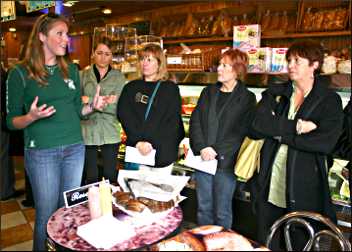
© Beth Gauper
Once, Chicago was a meat-and-potatoes town, the City of Broad Shoulders.
Chicagoans still brawl over who has the best deep-dish pizza and Chicago-style hot dogs, which come with no ketchup but so many condiments they're "dragged through the garden."
But these days locals are just as likely to seek out the best macarons and gelato, and on special occasions, they dine at Michelin-starred restaurants with avant-garde chefs who are more Jeff Koons than Betty Crocker.
Chicago today is a foodie town whose residents love food, period. Call it the City of Broad Hips.
Locals can go wild during Restaurant Week in February. Tourists have to run around trying to sample even a sliver of the many cafes, patisseries, ethnic markets and gourmet shops in each neighborhood.
Or, they can join a guided tasting tour and hit six or seven in one afternoon, as we did one fall.
We chose Chicago Food Tours for its tour in the Gold Coast and Old Town neighborhoods, starting at a Jewish deli.
Two blocks from tony Lake Shore Drive condo towers, it held cases of Eastern European/Jewish comfort food: potato pancakes, latkes, gefilte fish.
"You hear of Subway and Quizno; they're not the real deal," said our personable guide, Lauren McCabe. "This is the real deal."
She passed around plates of marble rye, homemade sauerkraut, garlicky peppered pastrami and Russian dressing with chunks of hard-boiled egg and sweet pickled beets. Piece by piece, we assembled Reuben sandwiches.
"You have to ask for the pastrami, or you'll get corned beef," McCabe said. "I think it's a lot better. This is from Vienna Beef — it was started by two Austro-Hungarian immigrants who made the first Chicago-style hot dogs at the 1893 World's Fair."
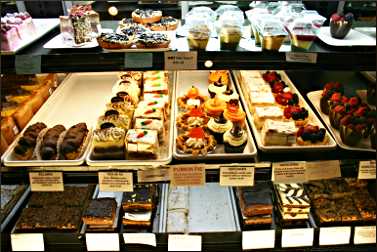
© Beth Gauper
Up the street, we walked into Tea Gschwendner, an outpost of the well-known German tea purveyor. Small stainless-steel bins lined its walls, each filled with exotic tea leaves from around the world, some costing more than $50 an ounce.
"The United States is the only country where the No. 1 beverage is not tea," McCabe noted, with a touch of disapproval.
First, we sniffed samples of loose leaves.
"Nine out of 10 times, if you like the way it smells, you'll really like the taste," she said.
We learned a lot about antioxidants and caffeine as we sampled the bossa nova, which had strong notes of vanilla and hazelnut, and an oolong that had delicate aromas of peach. We couldn't buy, though, because we had to hustle to our next stop.
To get there, we walked through the residential part of the Gold Coast, which locals call the Viagra Triangle because so many older men are seen there with young women, McCabe said.
One house was Hugh Hefner's first Playboy mansion; when he moved to L.A., he gave it to the Art Institute of Chicago to use as a freshman dorm, McCabe told us. The Latin inscription on the brass doorplate reads, "If you don't swing, don't ring."
Soon we reached Old Town, an old German neighborhood once nicknamed the Cabbage Patch, where Oscar Mayer owned a butcher shop. It was a hippie neighborhood in the 1960s and, despite its proximity to downtown, became a near ghost town after Democratic Convention rioting in 1968.
Gentrification followed revitalization in the 1980s, and today Old Town is full of chic bistros, markets and patisseries. It's a place where you want a fat wallet — and a fast metabolism.
At the Spice House, we parked our noses over bottles of seasonings, tapping out samples to taste.
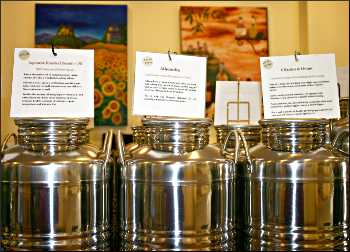
© Beth Gauper
In the vine-covered courtyard, we got a lesson in cinnamon, from the mild Ceylon cinnamon used in Mexican hot chocolate to the Indonesian "French toast" kind used by Cinnabon and the spicy Vietnamese style used in Big Red gum and Hot Tamales candies.
Like every spice at the Spice House, they're ground on the premises, every two or three weeks.
"After the sticks are ground, they'll turn to sawdust after a year," McCabe said. "But if they're unground, you could give them to your grandkids."
At Old Town Oil, we tried a few of the aged, infused vinegars straight from the tap, out of little plastic cups. Then we turned into chemists, mixing and matching the aromatic vinegars with olive oils: strawberry balsamic with Tuscan herb, white peach vinegar with basil oil.
Visions of summer salads danced in our heads as we hurriedly wrote down some of our favorite combinations. Then McCabe urged us onward to the Fudge Pot, one of the oldest Old Town businesses.
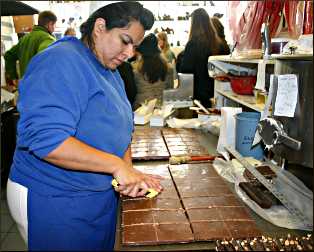
© Beth Gauper
Chocolate permeated the air as we walked behind the counter and picked large pieces of butter toffee from a platter. The shop has the usual array of fudge, caramels and creams but is famous for novelty chocolates —"including something used at bachelorette parties," McCabe said with a wink.
They're all made with 10-pound blocks of chocolate from Chicago's own Blommer's, the largest processor of cocoa beans in North America.
"We make, consume and sell more chocolate than anyone, including Hershey's, PA," McCabe said. "We kick Hershey's butt."
We took a bathroom break at the Second City Theatre, where rubber crustaceans were wrapped around the stone faces of famous German writers on the facade of the former Schiller theater, built in 1892.
On the next street, Delightful Pastries held many tempting trays of brownies, eclairs and other sweet things. But here, our samples were savory: apricot and cream-cheese kolaches, a type of less-sweet Danish, and potato-cheese pierogies, a filled dumpling.
Both are Eastern European in origin.
"Chicago has the largest Polish population outside Warsaw," McCabe said. "After the war, many were displaced to Austria, where they learned to speak German and bake a cake."
Obviously, our food tour couldn't be complete until we'd had a slice of deep-dish pizza. It came after a pleasant walk through Chicago's Mid-North district, one of the few with houses that survived the Great Chicago Fire of 1871.
On our way to the Lincoln Park neighborhood, McCabe entertained us with tidbits on local architecture and the local obsession, real-estate prices. She pointed out one International-style house that occupied a tiny lot on a shady street.
"The architect who built that big steel box got the lot for $11,000 in the 1970s, and now it's worth $1 million," she told us.
Just beyond Oz Park, we settled into the basement of Bacino's and dug into slabs of deep-dish spinach pizza.
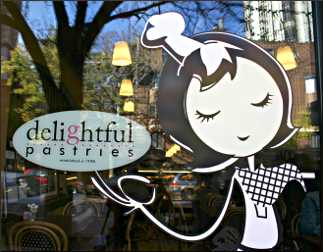
© Beth Gauper
"This is the No. 1 best-selling pizza at Taste of Chicago," McCabe said. "The pizza here is really fresh and light, made with no oil in the pan and fresh spinach. You're not going to feel overwhelmed by this pizza."
We were, though, because just one slice of deep-dish pizza is a whole meal. And oddly, the most "Chicago" stop seemed the most superfluous, after the nuanced fragrances and flavors we'd experienced at our previous stops.
As we ate, McCabe polled participants on their favorite stops. There was at least one vote for each, but the people who didn't say "all of them" tended to mention Old Town Oil and the Spice House — surprising, since neither sells "food."
We were among the few tourists; most of the other people on the tour were from Chicago or its suburbs, and one young woman and her mother lived in Lincoln Park. Not every Chicago resident is a foodie, but most are foodies-in-the-making.
"I was born and raised in Chicago, and I didn't know about these places," said one. Another had eaten pastrami for the first time on the tour.
We left Bacino's with full stomachs and, more importantly, a map of the stops and a fistful of discounts available only to tour participants.
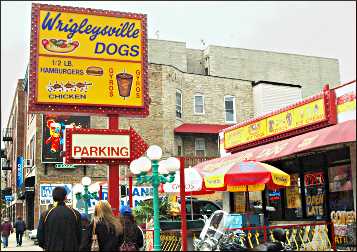
© Beth Gauper
"Old Town Oil, the Spice House and Tea Gschwendner are the places people run right back to," McCabe said.
She had us pegged — the next day, we hit all three. Now we're planning our next food tour. In Chicago, the more you try, the more you want to try.
Trip Tips: Chicago food tours
Each tour includes tastings or more at each stop, equal to a full meal.
Or, tour ethnic neighborhoods on your own, eating dim sum in Chinatown, Indian food on Devon Avenue, Swedish food in Andersonville and so on.
For restaurant recommendations and foodie lists, check the listings of Chicago magazine.
In July, dozens of restaurateurs provide samples at the free Taste of Chicago festival in Grant Park.
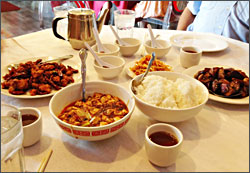
© Beth Gauper
Chicago Food Tours: Formerly called Chicago Food Planet, its guides lead two- to three-hour walking tours to five to seven rotating restaurants, bakeries and shops.
They're in the River North, West Loop, Pilsen and Chinatown neighborhoods.
Tours include many historical and architectural details and are given year-round.
Tastebud Tours: It offers three-hour walking tours of eateries in the Millennium Park-Loop area or Gold Coast, with overlapping stops. There are four themes: World's Fair Food, Iconic Flavors, Food and History and Taste of Chicago.
Tours run year-round, with five to seven stops.
Chicago Pizza Tours: These three-hour bus tours stop at pizzerias in different neighborhoods to taste different styles of pies.
Sidewalk Food Tours: These three-hour walking tours cover the River North and Wicker Park neighborhoods.
Chef Driven Food Tours: These 3- or 3.5-hour bus tours are guided by local chefs and include beer, wine and/or cocktails.
They cover the Pilsen, South Side and Little Italy neighborhoods, and there's a Sunday tour of the Maxwell Street Market and a Greatest Hits tour.
Chicago Beer Experience Beer Tours: These three-hour walking tours combine Chicago history with more than 10 beer tastings and a snack.
The Sin & Suds tour covers gangster hangouts in the Loop and South Loop.